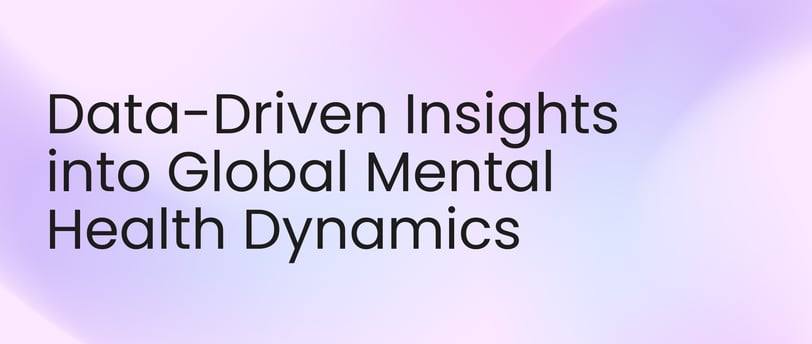Data-Driven Insights into Global Mental Health Dynamics
Chithralekha Rajeev
11/11/20232 min read


In an era where mental health is becoming increasingly recognized as integral to overall well-being, data analytics offers transformative insights into the prevalence and patterns of mental health disorders globally. This project represents a meticulous exploration into mental health data, using advanced techniques to uncover trends, correlations, and disparities across regions and time.
Project Objective
The primary objective was to analyze the global prevalence of mental health disorders, including schizophrenia, depression, anxiety, and substance use. By leveraging data analytics, we aimed to:
Identify Key Trends: Understand temporal and regional patterns of mental health disorders.
Cluster Regions: Group countries with similar mental health profiles for targeted interventions.
Examine Relationships: Assess correlations between disorders and their influencing factors.
Develop Predictive Models: Predict future trends to inform policymaking and resource allocation.
Dataset Overview
The dataset spans over 200 regions from 1990 to 2015, capturing the prevalence of various mental health disorders. Key features include:
Entity and Code: Unique identifiers for countries/regions.
Year: Temporal context for data collection.
Disorder Prevalence: Percentages for schizophrenia, bipolar disorder, eating disorders, anxiety, drug use, depression, and alcohol use disorders.
The dataset provided a comprehensive foundation for analysis, with each variable contributing to a nuanced understanding of mental health dynamics.
Tools and Techniques
K-Means Clustering:
Purpose: Group countries into clusters based on similar mental health profiles.
Approach: Used the elbow method to determine the optimal number of clusters and visualized clusters using Principal Component Analysis (PCA).
Principal Component Analysis (PCA):
Purpose: Reduce dataset dimensionality for clearer interpretation.
Outcome: Highlighted key components influencing mental health trends globally.
Multivariate Linear Regression:
Purpose: Understand the impact of factors on specific disorders, such as alcohol use.
Outcome: Built predictive models and identified significant predictors for disorder prevalence.
Visualization Techniques:
Box plots, choropleth maps, and 4D plots were used to present findings clearly and engage stakeholders effectively.
Methodology
Data Cleaning and Preprocessing:
Addressed missing values, standardized formats, and transformed variables for consistency.
Focused on retaining only the most relevant data for analysis.
Cluster Analysis:
Grouped countries into eight distinct clusters based on mental health profiles.
Visualized clusters to understand similarities and differences across regions.
Correlation Analysis:
Explored relationships between disorders, revealing significant correlations like bipolar and eating disorders.
Predictive Modeling:
Linear regression models were developed for alcohol use disorder trends, achieving an R² of 88.89%, indicating strong predictive power.
Key Findings
Regional Disparities:
High prevalence of alcohol use disorders in Belarus, while anxiety was more common in New Zealand.
Schizophrenia prevalence was highest in the Netherlands.
Temporal Trends:
Rising trends in anxiety and drug use disorders over 25 years.
Slight decline in depression prevalence post-2005, indicating potential progress in awareness and intervention.
Cluster Insights:
Cluster 3 had the highest prevalence of alcohol use disorders, necessitating targeted harm-reduction strategies.
Cluster 7 showed significant variability in anxiety and bipolar disorders, suggesting unique regional challenges.
Predictive Insights:
Schizophrenia had the highest influence on alcohol use disorders, with a coefficient of 98.83 in regression analysis.
Impact and Recommendations
This project provides actionable insights for healthcare professionals, policymakers, and researchers. The findings emphasize:
Awareness Campaigns: Educating communities about mental health to reduce stigma and promote early intervention.
Digital Tools: Developing mood-tracking and gamified recovery apps for proactive mental health management.
Regional Strategies: Tailored interventions for high-prevalence regions to address unique challenges.
Future Directions
Further research could enhance these findings by:
Incorporating more granular data on socioeconomic factors.
Using advanced machine learning models for better predictions.
Expanding the dataset to include post-2015 trends for updated insights.
This project exemplifies the power of data analytics in addressing global mental health challenges, paving the way for informed interventions and a healthier society.
